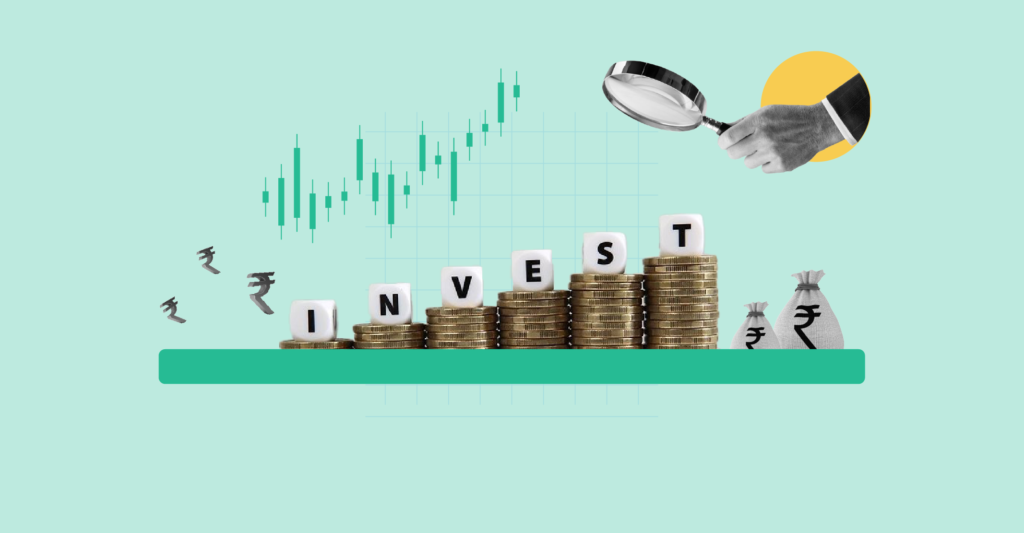Last Updated on Jan 19, 2024 by Anjali Chourasiya
With the uncertainty the world has faced in the past few years, you may wonder, ‘What is the best place to invest money in India?’ Well, investors are increasingly turning towards long-term investment options. These options can help you build wealth, hedge yourself against inflation, and take advantage of potential tax benefits. Here are the ten popular and best investments where you can invest money in India:
- Stocks
- Mutual funds
- Fixed deposits
- Gold
- Real estate
- Bonds
- Saving schemes
- SIP mutual funds
- ULIPs
- REITs
In this article, let’s understand each investment option and learn how to find the best investment option for your portfolio.
Table of Contents
Types of investments in India
Based on risk, there are three types of investment options in India.
- Low-risk investments in India
A focus on capital preservation and stability characterises low-risk investments. Typically, this category is favoured by individuals with a lower risk tolerance, such as retirees or those approaching retirement. Low-risk investment options in India include Fixed Deposits (FDs), Savings Accounts, and Government Bonds. Low-risk investors prioritise the security of their principal amount and consistent, guaranteed returns.
- Medium-risk investments in India
Medium-risk investments strike a balance between potential returns and moderate volatility. This category often appeals to those with a longer investment horizon. Best places to invest money with medium-risk options may include Mutual Funds, National Pension System (NPS), and Real Estate. Medium-risk investors seek a blend of stability and growth in their portfolios.
- High-risk investments in India
The potential for substantial returns characterises high-risk investments, but they come with higher volatility. This category attracts individuals with a higher risk appetite and a long-term investment horizon. Examples of high-risk options include individual stocks, equity mutual funds focused on aggressive growth and cryptocurrency investments. These choices can experience substantial price fluctuations, and returns are not guaranteed. High-risk investors often actively manage their portfolios and closely monitor market trends to capitalise on potential opportunities.
Based on the need and purpose of the investments, there are three broad classifications.
- Growth investment plans
Growth Investment Plans are designed to provide capital appreciation over the long term. These plans aim to deliver substantial returns by investing in assets with growth potential. Examples include stocks of companies with high growth prospects or sectors expected to outperform, equity mutual funds, innovation funds, individual growth stocks, etc. Growth Investment Plans typically carry a higher risk due to their exposure to market fluctuations. They are suitable for investors with a longer time horizon and a higher risk tolerance.
- Safe investment plans
Safe Investment Plans prioritise capital preservation and stability. These plans aim to protect the invested amount while providing modest returns. Safety is emphasised over high returns, making them suitable for conservative investors. Examples include fixed deposits, government bonds, savings accounts, and more. Safe Investment Plans have a low-risk level, making them suitable for investors prioritising capital preservation and seeking a predictable, stable source of income.
- Income investment plans
Income Investment Plans focus on generating a steady stream of income. These plans suit investors looking for regular cash flow and are less concerned about capital appreciation. Examples include corporate bonds, dividend stocks, REITs, and more. Income Investment Plans carry a moderate risk level. While they focus on generating income, there may be some exposure to market fluctuations, credit risk, or changes in interest rates. They are suitable for investors seeking a balance between income generation and capital preservation.
10 options where you can invest money in India
Here are ten options where you can invest money for good returns in India.
1. Stocks
Stocks are one of India’s most popular investment options. It is preferred by investors looking for long-term options with good returns. However, it is important to note that investing in stocks involves risk, and you need to invest only if you understand the market well. As an investor, you need to do proper research before investing in stocks.
There are different types of stocks, like growth stocks, value stocks, etc. All these stocks can be filtered according to key parameters like market cap, net profit, etc. You must understand which sector the stock belongs to, management, market scenario, etc.
You can use Tickertape’s Stock Screener to find the best stocks in India. With Tickertape’s 200+ filters, you can quickly and easily narrow down your search to find stocks that meet your specific criteria. You can also create custom filters to find stocks that meet your exact needs. In addition to this, you can also create a custom stock universe to focus your search on a specific group of stocks. This is a great way to save time and focus on the stocks that are most relevant to you. Start your search for the best investment opportunities today; explore the screener now!
To understand deeply how to invest in stocks, read this article.
2. Mutual funds
Mutual funds are a common pool of money invested in multiple assets like equities, bonds, etc. A fund manager manages it. It allows you to diversify your investment portfolio, which can help you mitigate risk.
There are different types of mutual funds: debt, growth, hybrid and more. The fund manager considers your investment objective and risk appetite and invests in a fund that suits you. They are preferred for both long-term and short-term investment horizons.
Yet again, similar to stocks, there are various mutual funds in the market. But Tickertape comes to your rescue. You can use Tickertape’s Mutual Fund Screener to filter the best mutual fund according to key parameters like assets under management (AUM), net asset value (NAV), annual returns and more. There are over 50 filters, custom filters, a custom mutual fund universe, pre-built screens, custom screens, individual fund analysis, a mutual fund watchlist, and more. Learn How To Use Tickertape Mutual Fund Screener To Pick the Best Fund.
One of the many benefits of investing in mutual funds is that you can avail a loan against mutual funds. To understand how to find the best mutual funds and ways to invest in mutual funds, read this article.
3. Fixed deposits
This is one of India’s traditional and popular investment options. Fixed deposits (FD) are one of the first results that come to your mind when someone asks where to invest money in India. The reason behind its popularity is the minimal risk profile with decent returns.
Fixed deposits are offered by banks, post offices and Non-Banking Financial Companies (NBFCs). They are suited for your lump-sum investment to grow and also offer interest at regular intervals. The interest rate on FDs varies with the bank or the NBFC. You can leverage your investment in fixed deposits by availing a loan against them. Read more about it here.
4. Gold
This is one of India’s oldest and most popular investment options. Gold is considered an auspicious metal in India and is known for its value appraisal benefit. It acts as a hedge against inflation and is considered a low-risk investment.
The traditional way to invest in gold is through ornaments, coins or bars. Recently, several gold investment options like gold deposits, gold ETFs, and gold mutual funds have come up. If you are wondering if digital gold is a good investment, then find out your answers here.
With many gold investment options available in India, it is difficult to understand each investment and how to invest in them. Well, don’t fret; we have created a guide for you to understand how to invest in gold. Read it here.
You can start your journey of investing in Digital Gold on Tickertape in a few easy steps: enter the amount you want to invest in, start a habit of investing or investing one-time, and voila, you’re done. It’s that easy; you can keep a check on your gold investment by tracking them on your portfolio on Tickertape.
You may also like to read 5 Reasons to Invest in Digital Gold.
5. Real estate
Investing in real estate is also one of the popular investment options in India. Though it involves a good amount of investment, its returns are huge. You can get returns either when you sell it or monthly in the form of rent. But while buying or selling, ensure to consider all the related charges like registration fees, property taxes, and more. It can be considered a good investment option for the long-term horizon.
6. Bonds
Similar to individuals, companies or governments need money to grow and develop. To raise funds for their company, they offer bonds. You can buy those bonds for a fixed interest and tenure. It is considered a low-risk investment option in India, especially when they are government-backed. Learn more about bonds here.
7. Saving schemes
As the name suggests, saving schemes help you save your monthly income for a period of time, which turns into a big corpus. These are backed by the government, banks or financial institutions. The savings scheme has a lock-in period and encourages you to save regularly. They are considered low-risk, long-term investment options that don’t require a lump-sum investment.
Employee Provident Fund (EPF), National Pension Scheme (NPS), National Savings Certificate (NSC), Post Office Savings Account, Senior Citizen Savings Scheme (SCSS), etc. are a few popular savings schemes in India.
8. SIP mutual funds
Well, you know about mutual funds, but did you know that all mutual funds don’t require a lump-sum investment amount? Yes. Systematic Investment Plan (SIP) is a type of mutual fund which doesn’t require lump-sum investment. The investment in SIP starts at Rs. 100 and allows investment at regular intervals. So, if you are interested in investing in mutual funds but are worried about lump-sum investment, SIP can be your go-to option.
Through SIP, you can invest monthly in a disciplined manner and avail yourself of the benefit of compound interest. You can visit Tickertape to find the list of SIP mutual funds in India. Go to Mutual Fund Screener and search for ‘SIP Investment’ in ‘Add Filters’. Find the list of SIP mutual funds in India and sort them according to your preferred parameters like AUM, NAV, 1-yr returns, etc.
9. ULIPs
Unit Linked Insurance Plans (ULIPs) are provided by insurance companies. Here, a portion of the investment is invested in stocks or bonds, while the remaining is invested in life insurance. Overall, it invests in equity and debt markets while simultaneously offering protection to the investor. It covers returns, protection and tax-saving as well. However, as it involves equity, there is a certain risk involved. Learn about them here, along with everything you need to know about ULIPs and the five best ULIP plans to secure your future.
10. REITs
Real Estate Investment Trust (REIT) is an investment option similar to mutual funds where investors pool in investment and REIT companies manage the investment. They invest the funds in primary real estate buildings and mortgages. They generate money from the rental income, and the investors will get a portion of the returns in the form of dividends. Learn more about this investment here.
How to invest in India?
Apart from the ones discussed above, there are various other investment options in India as well. The risk profile of each investment is different, and no investment suits all your investment needs. Hence, you need to understand each investment option carefully and pick the ones that suit your objective. You need to create a diversified investment portfolio to mitigate risk. Your portfolio should be well-balanced; even if one investment is not doing well, the profit on the other ones should be able to compensate. To check if your portfolio is well-diversified, connect it with Tickertape.
Tickertape’s Diversification Score is a powerful tool that provides insights into their portfolios and helps them make informed and profitable investment decisions. The Diversification Score ranges from 1 to 100, and the higher the score, the closer the portfolio is to being perfectly diversified and less volatile. If the score is too low, you can further diversify your portfolio by adding stocks from other sectors or market caps. Proper diversification can help you achieve better risk-adjusted returns and protect against market volatility. It sure helps to mitigate red flags, too! So, what are you waiting for? Connect your portfolio now!
Factors for choosing the right investment plan
When picking the right investment plan in India, it’s important to think about a few key things. Here are some of the main factors to keep in mind:
- Financial goals: Figure out what you want to do with your money. It can be buying things, saving for your kids’ education or weddings, getting a home, or planning for when you stop working. Your investment choice should match up with these goals.
- Risk tolerance: Decide how comfortable you are with taking risks. If you’re okay with more risk, select investments from the list of high-risk. If you want less risk, you might go for plans backed by the government or those offering higher security. Talking to an expert while charting out investments based on risks is always worthwhile.
- Performance: It may be one of the key factors when choosing the investment for your portfolio. Checking how well an investment has done in the past can give you an insight into their earnings and how they work. It will help you set the right expectations and pick the best one for your portfolio, among many other options. For example, if you’re thinking about mutual funds, see how much money they’ve made before and compare that to other choices.
- Lock-in period: Some investments lock your money in for a specific time. For instance, ELSS funds make you wait for 3-yrs before you can take out your money. Choose an investment with a wait time that fits your goals and needs.
- Expense related to investment: It is always worthwhile to know about the costs connected to your investment. For example, mutual funds come with an expense ratio and an exit load. Understanding these costs before investing will give you a clear picture of how much money you may end up with and how much you have to pay for each investment.
- Market conditions and trends: Keep an eye on what’s happening in the market. For example, when things are uncertain, gold prices usually go up because people see it as a safe place for their money. By thinking about these things based on what you need, you can choose the best investment plan for you.
Conclusion
Finding the right investment option that suits you may not be an easy task, but once you understand the working, you’ll be able to make wise decisions and help your wealth grow. If you are new to the investment world, try learning the concepts. Make use of the Blog by Tickertape that explains investment concepts in simple terms and provides expert opinions. And there are financial advisors to help you with investment choices.
FAQs
Where to invest money in India for maximum returns?
There are investment options like stocks and mutual funds that offer high returns, but they are also considered highly risky. Therefore, invest only after considering your investment objective and risk appetite.
Where to invest money in India for monthly income?
Investments like real estate, provident funds, fixed deposits, etc., offer monthly income. The monthly income depends on the scheme you pick.
What are the investment options available with low risk?
Fixed deposits and provident funds are considered low-risk investments compared to other investment options.
What are the best stocks to invest in?
There are 7000+ companies listed on the Indian stock exchanges. The best ones can be picked based on different parameters like market cap, net profit, 5 yr CAGR, annual returns, and more. Use Tickertape Stock Screener to filter the best stocks in India. There are 200+ filters that can help you understand the performance of a stock better.
Where can I invest my money?
The top 10 investment options in India are Stocks, Mutual funds, Fixed deposits, Gold, Real estate, Bonds, Saving schemes, SIP mutual funds, ULIPs, and REITs.
How to invest money with a low budget in India?
You can start by exploring low-cost investment options like SIPs (Systematic Investment Plans) in mutual funds, government savings schemes, etc. These allow you to invest with a small budget, ensuring diversification and potential growth over time.
- Best Passive Mutual Funds in India: Top Index Options for 2025 - Mar 28, 2025
- Best Short-Term Mutual Funds in India for 2025 - Mar 28, 2025
- List of Top Small Cap Funds India for 2025 - Mar 27, 2025




